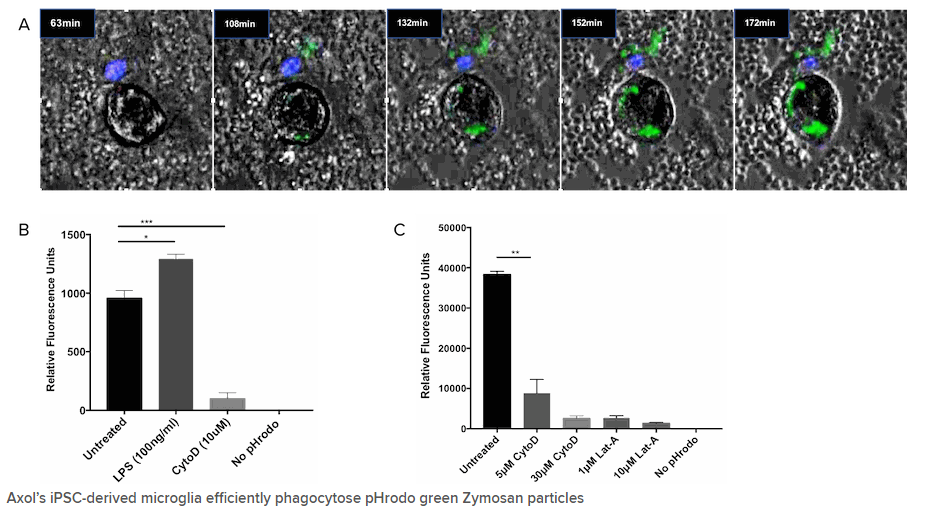Immunocytochemistry of Human iPSC-derived Microglia, after 18 days in culture, revealed the expression of IBA-1 and CX3CR1 (a chemokine receptor) as well as the microglial-specific markers TMEM119 (a transmembrane protein), and P2RY12 (purinergic receptor). All 3 markers co-localized strongly with the myeloid marker IBA-1, confirming identity of brain-resident-like microglia.

A) pHrodo is a fluorogenic dye that dramatically increases in fluorescence as the pH of the surroundings becomes more acidic, such is the case in the lysosome. pHrodo® Green Zymosan BioParticles® (Life Technologies) were added at 0.5 mg/mL to day 19-microglia plated at 1x105sup>/cm2, and incubated for 3hrs at 37oC, 5% CO2. Nuclei were counterstained with a live Hoechst 33342 stain and live cell imaging was carried out using an on-stage incubator connected to an EVOS Fl Auto imaging system (Life Technologies). Two activated microglial cells can be seen consuming increasing numbers of BioParticles® over time leading greater and more intense fluorescence emission. B) and C) Microglia seeded at 1x105/cm2 (B) or 3x105cm2 (C) were pre-treated with 100 ng/mL lipopolysaccharide (LPS) for 1hr (B), 5, 10μM or 30μM Cytochalasin D (CytoD, phagocytosis inhibitor) or 1μM or 10μM Latrunculin A (Lat-A) for 30mins (B) or 1hr (C) before adding pHrodo® Green Zymosan BioParticles® at 0.5 mg/mL and incubating for 3hrs at 37oC, 5% CO2. Lat-A inhibited phagocytosis more strongly than CytoD, in line with Lat-A being a more potent inhibitor of actin polymerization. Fluorescence was quantified using a SpectraMax iD3 microplate reader (Molecular Devices), and values were blanked against a no-cell control well. N=4 for both experiments, One-way ANOVA *P<0.05, **P<0.01, ***P<0.001
Further Functional Phagocytosis data (courtesy of Medicines Discovery Catapult; Alderley Edge, Cheshire, UK)
Phagocytosis is used as a primary measure of functional Microglia activity. The Cryopreserved Microglia (ax0668) exhibit substrate-dependent phagocytosis when exposed to fluorescent pHrodo labelled beta-amyloid. The Human IPSC derived cryopreserved microglia are shown to be highly phagocytic in nature and equivalent to fresh cells.